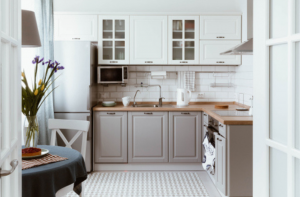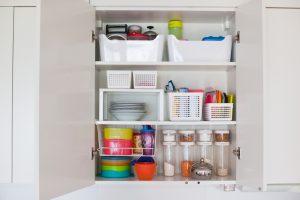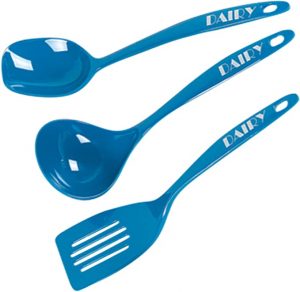
What’s Hot in Food & Cooking – A few tips to a more organized kitchen
 Most of the tips available to help one organize a kitchen are aimed at a non-kosher home. For people who keep kosher the tips generally fall short as we have double, if not triple, of everything for everyday use, as well as a full set of everything stored for Passover. How are we supposed to organize in spaces that were not specifically designed to meet our needs? Without undertaking a major kitchen remodel there are a few things that can be done to make the kitchen space you have more functional and less cluttered.
Most of the tips available to help one organize a kitchen are aimed at a non-kosher home. For people who keep kosher the tips generally fall short as we have double, if not triple, of everything for everyday use, as well as a full set of everything stored for Passover. How are we supposed to organize in spaces that were not specifically designed to meet our needs? Without undertaking a major kitchen remodel there are a few things that can be done to make the kitchen space you have more functional and less cluttered.
Before you organize you need to take stock of your kitchen – both space-wise and kitchenware, as well as the meals you prepare and for how many you are preparing those meals on a regular basis. If your family eats mostly meat meals then the majority of your kitchen space should be dedicated to that. If you eat mostly dairy, the majority of your space should be dedicated to that. For those of you who eat mostly plant-based or parve diets the same would hold true in your kitchen.
meals then the majority of your kitchen space should be dedicated to that. If you eat mostly dairy, the majority of your space should be dedicated to that. For those of you who eat mostly plant-based or parve diets the same would hold true in your kitchen.
As daunting as this seems, the best way to do this is to empty all of your kitchen cabinets and pantry storage. Lay down tablecloths on the floor in your dining area or in the main room of your home and divide everything according to designation. Dairy equipment in one area, meat equipment in a second and parve equipment in a third. By doing this you can see what category you have the most equipment and dishes to work with. This also gives you the ability to look at things and decide if you really want to keep them. If you haven’t used an appliance or gadget in over a year, get rid of it. If you have a container without a lid or a lid without a container, toss them – you don’t need to keep this clutter.
 The next step is to give your now-empty kitchen a thorough cleaning. Cabinets, shelves, closets. After everything is clean, decide if you need to line your cabinets or shelves. It is easier to do that now while everything is empty. Be creative in your storage solutions. Do you have a closet in another part of your home that is relatively unused? This could be a great place to store appliances when not being used. You may need to remove a hanging bar and add some shelving but if it frees up space in the kitchen go for it.
The next step is to give your now-empty kitchen a thorough cleaning. Cabinets, shelves, closets. After everything is clean, decide if you need to line your cabinets or shelves. It is easier to do that now while everything is empty. Be creative in your storage solutions. Do you have a closet in another part of your home that is relatively unused? This could be a great place to store appliances when not being used. You may need to remove a hanging bar and add some shelving but if it frees up space in the kitchen go for it.
There are a plethora of organizational items out there but you don’t have to spend a fortune. Use what you have first and then decide if you need to purchase anything. If you do have the budget, purchasing containers that stack well is the key, whether we are talking about containers for storing leftovers or bins for holding supplies. If you have an abundance of pots, pans etc. think about selling or giving the extras away. You don’t need 6 saucepans in the average home kitchen. One of each designation is usually enough.
 Once everything is divided into meat, dairy or parve categories and your kitchen is clean it is time to start organizing! Make the most of each space – use drawer dividers or utensil organizers for your cutlery and knives. Dishes can be stacked and shelf dividers help to keep them neat and orderly. Baskets and plastic boxes make pantry spaces less cluttered. If you live in a climate or area that is prone to infestations of bugs (not necessarily a reflection on your ability to clean, some areas are just more prone to this) think about storing dry goods and grains in glass or plastic containers that have tightly sealing lids. You will find the shelf life of these items is extended a bit as well by storing them in airtight containers. The added benefit is that you can purchase storage containers that stack neatly and make more space available in your pantry.
Once everything is divided into meat, dairy or parve categories and your kitchen is clean it is time to start organizing! Make the most of each space – use drawer dividers or utensil organizers for your cutlery and knives. Dishes can be stacked and shelf dividers help to keep them neat and orderly. Baskets and plastic boxes make pantry spaces less cluttered. If you live in a climate or area that is prone to infestations of bugs (not necessarily a reflection on your ability to clean, some areas are just more prone to this) think about storing dry goods and grains in glass or plastic containers that have tightly sealing lids. You will find the shelf life of these items is extended a bit as well by storing them in airtight containers. The added benefit is that you can purchase storage containers that stack neatly and make more space available in your pantry.
Make sure to clearly mark what is what – inside your drawers or cabinets put stickers designating the status of the items stored there – dairy, parve or meat. This will help children, guests and cleaning help put things in the right location. Another great habit to take on is to try to store leftovers in clear glass containers. Aluminum foil wrapped pans and dishes are soon forgotten and become waste. If something is clearly visible in your refrigerator your family is more likely to eat it than forget it exists. Teach your children and spouse from the beginning if there is less than a serving of something left in a container either finish it or toss it. Don’t leave a quarter of a teaspoon of mayo in the jar for the next person to discover. A magnetized pad of paper on the outside of the fridge or a shared grocery app are perfect for letting whoever does the food shopping know when things are running low. When freezing foods make sure that containers are clearly labeled; there is nothing worse than those mystery bags of frozen food – Is it meat? Is it dairy? Is it parve? While you are labeling, remember to date the foods you freeze. If you haven’t used it in six months, toss it.
 Use color coding to help keep things organized in your kitchen. In most kosher homes red is used for meat items, blue for dairy and green to designate parve, but you don’t have to stick to that. You can find kitchen gadgets and accessories made specifically for the kosher kitchen in those colors or you can just look for these things in the colors you want as you purchase them. The important thing is that you have a system in place that makes it easy for you to navigate your kitchen and to maximize your space.
Use color coding to help keep things organized in your kitchen. In most kosher homes red is used for meat items, blue for dairy and green to designate parve, but you don’t have to stick to that. You can find kitchen gadgets and accessories made specifically for the kosher kitchen in those colors or you can just look for these things in the colors you want as you purchase them. The important thing is that you have a system in place that makes it easy for you to navigate your kitchen and to maximize your space.

Related Articles
Related
Easing Our Stress By Simplifying Our Lives
Information overload. The stress piles on and the mountain of work seems insurmountable. We live in times of exciting inventions and technological developments that are supposed to make our lives easier while more productive. However, many people feel that they are...
Ruti’s Remedies: It’s Never Too Late
Ruti's Remedies Dear Ruti, In last month’s response [February: 8 Keys to Healthy Communication with Your Kids], you made a comment that it’s never too late to build the bridge of a safe place for communication with your children. With all due respect, I challenge...
No Hiding Allowed – 2 Looks for Mommies
Myth: If you’re a mother, you need to only wear clothes that are casual and comfortable and not stylish or flattering.. Truth: If you’re a mother, you absolutely should consider wearing clothes that are fitted and flattering as well as being casual and...
